Interstellar Ark
Gilgamesh, 14 February 2007 in PhilosophyOther Languages:
The concept of star travel, from planetary system to planetary system, is at the same time completely familiar and completely uncharted. Familiar, as we have certainly all heard of science fiction stories set on a far galaxy, where planets are nations or provinces of an empire. The characters usually move from one planet to another during intervals of time consistent with the story. The actual travel appears just like a formality, which the future advancements of a Triumphant Physics will put within reach.
This is what I’ll call the “strategy zero” (S0) : here travel is “instantaneous” or at the very least quicker than one year, eg. comparable to the durations of terrestrial travels or manned missions to the moon or other solar system’s bodies.
The way toward stars becomes however quite unfamiliar if we consider that such Triumph of Physics could possibly not happen, and that the famous constant of Einstein c, the speed of light (3E8 m/s), represents an horizon speed which is impossible to exceed and which is even extraordinarily difficult to approach, so that we would begin to see outer space like it is seen by astronomers: a vastness compared to which that of terrestrial oceans is nothing.
It is not without reserve that our mind adapts to the true dimensions of interstellar space. The insanity of these distances is not the only reason: in a sense, one could say that the “strategy zero” is enracined in a child’s desire of space. Not of a space-distance, of a horridly naked space, speechless and fearless, but of a space-treasure, and of the worlds which roll within its vastness. All these worlds whose reach should not suffer any delay and whose discovery turns on our imagination.
Realism helping, we leave with some regret the green paradise of “strategy zero”, but we can still consider a little more “teenager” strategy, within the framework of Special Relativity, which we will name “short strategy” or SI, which promises a travel duration within a man’s lifetime.
Short strategy : the relativistic rocket
In SI, which is specifically relativistic, one benefits from the contraction of traveller’s proper time ( ) when its velocity approaches c. If t is the time for a stationary observer,
) when its velocity approaches c. If t is the time for a stationary observer,

where  is the Lorentz factor,
is the Lorentz factor,

When v/c approches one,  tend toward infinite and
tend toward infinite and  tend toward zero. In other words, by approaching the speed of light the traveller’s time runs slower and slower so as one light-year may be traversed in less than one year of traveller’s proper time. This is the principle of the relativistic rocket. The only theoretical limit is the acceleration, which should be kept within physiologically acceptable limits for a human, that is to 1 g or 9,81 m/s².1
tend toward zero. In other words, by approaching the speed of light the traveller’s time runs slower and slower so as one light-year may be traversed in less than one year of traveller’s proper time. This is the principle of the relativistic rocket. The only theoretical limit is the acceleration, which should be kept within physiologically acceptable limits for a human, that is to 1 g or 9,81 m/s².1
The table below gives an idea of the travel durations and the reachable distances depending on the v/c ratio, by constraining acceleration to a constant value of 1 g (this constraint is extremely demanding as we will see):
ly = light-years (1 ly ~ 10 000 billions km)
1 g = acceleration of 9,8 m/s per second, measured in the traveller’s reference frame
 and t in years, d in light-years, v/c and
and t in years, d in light-years, v/c and  dimensionless
dimensionless

Thus, in just 12 years of proper time (but 113 243 years for the stationary observer), which is a long time but still bearable in a comfortable spaceship, one could traverse the whole Galaxy, whose diameter is 100 000 light-years. But this still requires to approach very closely the speed of light. It should also be considered that, if one wants to arrive at destination at zero speed, it is necessary to reverse the direction of thrust at midway in order to slow down; so that the travel duration is appreciably twice longer, which still remains reasonable. The total travel time (proper time of the traveller) to arrive at zero speed on a target located at D years light, while accelerating and decelerating at the constant rate of 1g in its reference frame is:
 = 1,94 arccosh (d/1,94 + 1) years
= 1,94 arccosh (d/1,94 + 1) years
For d = 100 000 ly (Galaxy extent),  = 22.4 years. Thus, if we consider travel duration, SI allows to reach targets as remote as wanted within durations not exceeding human lifespan. It is on this basis that we define this strategy : duration of terrestrial travels (1 year) <
= 22.4 years. Thus, if we consider travel duration, SI allows to reach targets as remote as wanted within durations not exceeding human lifespan. It is on this basis that we define this strategy : duration of terrestrial travels (1 year) <  < human lifespan (less than 100 years).
< human lifespan (less than 100 years).
Energy considerations
The difficulty of SI is about energy. All happens as if one must pay on the side of energy what one did not spend on the side of travel duration. Let us consider the most favorable case. The propulsion is more effective when one ejects behind oneself the lightest possible projectile at the highest possible speed. The absolute optimum is thus reached when all the fuel is converted into photons (zero mass) collimated behind the spaceship. The only reaction allowing 100% conversion of fuel into photons is the reaction matter-antimatter. It would be then needed to collimate the photons in a gamma laser beam (“graser”) in the ideal case. Neither the antimatter fuel, neither its combustion, nor the gamma laser collimation are within reach of our current technology, but this sets the theoretical maximum. The ratio of the total fuel mass (matter + antimatter) M0 on the spaceship mass M is in this case :

with a = 9,8 m.s-2 = 1,02 ly.year-2
c = 3e8 m.s-1 = 1 ly.year-1
 in years
in years
To reach the other end of the Galaxy ( = 22.4 years) it would be needed to take 10 million tons of fuel for each kilogram of spaceship structure. This is the absolute theoretical minimum, based on a propulsion efficiency of 1 (which cannot never be reached, as the reaction would produce neutrinos carrying part of the impulse in all directions) and which does not take into account the energy costs of the antimatter production. Antimatter must be produced in particle beams accelerated by classical means. For fundamental reasons (conservation of the baryon number), the maximum theoretical conversion rate is 1/2. In practice in current accelerators it is much lower, about 4E-8 (that is, one antiproton produced every 400 million collisions). One can reasonably hope to gain 3 to 4 orders of magnitude but nothing more can be foreseen beyond such technological horizon.
= 22.4 years) it would be needed to take 10 million tons of fuel for each kilogram of spaceship structure. This is the absolute theoretical minimum, based on a propulsion efficiency of 1 (which cannot never be reached, as the reaction would produce neutrinos carrying part of the impulse in all directions) and which does not take into account the energy costs of the antimatter production. Antimatter must be produced in particle beams accelerated by classical means. For fundamental reasons (conservation of the baryon number), the maximum theoretical conversion rate is 1/2. In practice in current accelerators it is much lower, about 4E-8 (that is, one antiproton produced every 400 million collisions). One can reasonably hope to gain 3 to 4 orders of magnitude but nothing more can be foreseen beyond such technological horizon.
The SI strategy, realistic on the level of travel durations, quickly ceases to be realistic on the level of energy requirements. Of course, when considering the alternate “long” strategy (SII), one should keep in mind that SI-SII form a continuum, and that what is required is to find the intermediate optimum. In particular, the above scenario is a limiting one which would be not considered, as requiring a constant acceleration of 1g throughout the way is an extremely expensive condition in term of fuel consumption.
In a more general case, where a period of non-accelerated flight is allowed before decelerating, and without reaching the limiting case of an ejection of photons, the ratio of the departure mass M0 (structure + fuel) on the arrival mass M (structure alone) is calculated as follows:
![\frac{M_0}{M}= \left[\frac{1+\frac{v}{c}}{1-\frac{v}{c}}\right]^{\Large{{\frac{c}{v_e}}}](https://strangepaths.com/wp-content/cache/tex_811774b8211d097294ac4365233164e2.gif)
with c the speed of light
v the coasting flight velocity (which is also the maximum velocity)
ve the fuel ejection speed (ve < c)
The above mentioned optimum should mean determining the energy minimum allowing to reach a potential stellar target. Such minimum is determined according to the technological and political level of humanity, and there is of course a possible interaction between the goal and the actors. One can suppose reasonable that the interest expressed by mankind for its galactic environment will imply a "passage to the act" as soon as the energetic barrier problem is considered solved at some point, within the first target falling in range within this barrier. And this, even if the duration of travel is very large. This is because, unlike for the energy barrier which has no maximum, the time barrier has a kind of plateau at some canonical duration which one may set equal to about a century. If a single man is able to consider without regrets to live his whole life in a spaceship on the way towards stars, then time is no longer a barrier and the only constraint is the energy needed to build, drive and maintain the spaceship structure. It is this temporal plateau which makes it possible to lower the energy barrier, and the long strategy is based on a multi-centuries duration.
Scarcity of planetary systems
There is another aspect than energy to take into account, which pertain not to astronautics (rockets, engines…) but to astrophysics and exobiology. It is the planet-target or rather the entire stellar system target, including its small gray bodies (asteroids, comets).
One can only accelerate small structures at relativistic speeds, given the magnitude of the M0/M ratio allowing to reach such speeds. Small structures which should nevertheless accommodate as more human beings as possible, so as to ensure sufficient genetic diversity, that is at least 1,000 people.
It would be possible to lower the structure requirements in the relativistic case by hibernating an appreciable fraction of the occupants.
But this would imply the strong requirement to find a target planet immediately habitable without terraforming.
On at least a few hundreds contiguous km², one should ensure of the following minimal environmental conditions:
- Gravity: 0,5 - 2 g
- Annual amount of radiation: < 100 milliSievert
- Atmospheric pressure: 0,5 and 5 atm
- O2 partial pressure: 0,1 - 0,5 atm
- Temperature : -50 and +50°C
- Presence of water at surface or sub-surface
- Absence of pollutants
To reach Earth’s standards, we should add:
- diversified climatic systems based on the water cycle
- liquid water oceans
- stellar spectrum at ~6000°K
- lenient ecosystem
In addition, planning a short strategy to reach a very distant body implies to reach a target which one knows only remotely. Because if it is question of sending automatic probes to explore the system beforehand, then they should also move at relativistic speeds while the future travellers would be at rest, waiting for information to return by radio transmission. But since the target is located beyond a few light-centuries, the latent period (a millennium for a target located at 500 ly) exceeds the travel duration to a closer system in the long strategy, even if the target is less viable, we will see why.
Concerning the frequency of livable planets in the stellar systems, next decades should bring much information which we await with much impatience. But it does not seem presumptuous to me to predict that this frequency will be found low, when considering the requirements enumerated above. Consequently there could be very little chances to find some in the vicinity, say to less than 20 light-years. The number N of stars located at a distance R from the Sun is:
N = bR3
with:
b ~ 0,017 stars.ly-3 for R<250 ly
R in light-years
The star spectral type (i.e. its surface temperature) should be similar to that of the Sun (G2), which restricts the potential targets to types F, G or K, accounting for approximately 20% of nearby stars. We may add that about half stars belong to a multiple system, which is less likely to host stable planetary orbits.
Let's set to 10% the ratio of FGK systems tolerating the presence of a telluric planet in a stable orbit at the right distance from the star.
Nhab = 0,1 N
That gives a series of sample values for N and Nhab for increasing distances in light-years from the Sun:

We can see for example that if less than 1% of stellar systems include a planet of terrestrial morphology, then there is little chance of finding one at less than 40 light-yearsl.
Even by assuming exponential advances in observational astrophysics, when one can expect that a purely radioelectric observation of a remote system, located at hundreds, thousands or tens of thousands light-years could deliver completely satisfactory information allowing to predict the possibility to colonize it “right from landing”? And this, particularly with regard to its ecosystem. There is undoubtedly not much to fear from the very large (wild animals…) or nano (viruses, requiring compatibility of genetic systems). But mico-organisms of bacterial or fungic type require a simple organic substrate to develop. Such risk remains reasonable, but it counts in the total incurred risk. Everything can happen, and everything should be considered by the travelers, in a much more dramatic way than this reflection may do. A colony reduced to the minimum in a vessel itself minimal, is delivered feet and fists tied to the slightest unforeseen, without hope of any terrestrial help, not even moral. How can one imagine more unforeseen than such a first way out of the solar system? What would happen if the 20 planned years would result in 200 years of confined life?
From this, one may conclude that humankind cannot reasonably venture in the surrounding immense spaces without being rigorously autonomous and detached of any calendar, with the only exception of the energy requirements.
The long strategy aims this autonomy. The energy needed for propulsion at “low” speed (0.015 c) and for the maintenance of a large structure, comparable to a micro-planetary body of gigaton mass, for a duration close to a millennium is comparable with that necessary to the propulsion of a thousand times less massive body at relativistic speed (0.9 c), which supposes ejection of great amounts of fuel at a speed very close to c (say 0.99 c), which is at the borders of our technological horizon. The long strategy constitutes the more “classical” of the solutions, thus the least technologically demanding. S0 strategy is based on theoretical advances, even more than technological ones, located outside of our horizon, and supposing that such solutions do actually exist. It can neither be evaluated nor discussed. SI is based on a well established relativistic physics, but whose practical application demands energy sources which are not available when aiming a very distant target in a lifetime duration. Technologically, it needs to achieve an ejection velocity at the borders of our technological horizon. It also implies a small structure which cannot stand a long term autonomy. SII is both safer and located within our horizon of possibility, even if it is not one of this century.
Long strategy: the Ark
The most effective propulsion which may be achieved within our technological horizon is nuclear fusion. The principle is to confine light nuclei at very high temperature to produce their fusion in a very hot plasma, with electric power allowing ejection of plasma in a magnetic conduit.
This principle would allow to reach ejection velocities of 20,000 km/s. In order to be used as a source of energy, a nuclear fusion reaction must satisfy several criteria. It must:
- be exothermic, which limits reagents to the part of the binding energy curve corresponding to light nuclei, with few protons, making helium-4 (more rarely deuterium and tritium) the headlight reaction product because of its strong binding energy,
- imply nuclei with few protons because of the need to overcome the coulombic repulsion so that nuclei may approach sufficiently to achieve fusion,
- have no more than two reagents: for densities lower than those of stars, the production of three simultaneous collisions is too improbable. It should be noted that in inertial confinement one both exceeds stellar densities and temperatures, which makes it possible to compensate for the weakness of the third parameter of Lawson’s criterion, the very short duration of confinement,
- have at least two products of reactions allowing the simultaneous conservation of energy and impulse,
- conserve at the same time the number of protons and neutrons. Cross sections for the weak interaction being too small, the reaction p + p -> D is unusable, even if it is the one which takes place in the Sun and is constantly flooding us with energy. Proton half-life (the average time needed by a proton to react with another proton to form Deuterium, starting the feedback chain leading to helium-4) under the extreme conditions of temperature and density in the nucleus of a star (density: 150 g/cm3, temperature: 13 millions degrees Kelvin) is about 10 billion years. This as in order to occur, the reaction requires a beta decay, that is the spontaneous conversion of one of the two reactional protons into a neutron (a purely “weak” phenomenon), and this, at the very moment of the interaction p-p.
Nuclei (or isotopes) available for the reactions are:
(01) 1H or p, light hydrogen or proton, the most usual,
(02) 2H or D, heavy hydrogen or deuterium, present in small quantity (0.0015% in terrestrial water that is 15 ppm), and maybe 10 times more in some small bodies of solar system, primarily as heavy water HDO),
(03) 3H or T, tritium, instable, with period 12.3 years, therefore absent in natural materials,
(04) 3He, He3, helium-3 present as a trace in the lunar ground and the atmosphere of giant planets,
(05) 6Li, Li6, lithium-6,
(06) 7Li, Li7, lithium-7,
(07) 11B, B11, boron-11,
the latter 3 elements being present as a trace (estimated 6-7 ppm) in the small bodies of solar system.
The fusion reactions concerning these isotopes are:
n represents neutron (in bold when it can breed deuterium).
1 MeV : 1 million electron-volts (eV). 1 eV = 1,602E-19 Joules
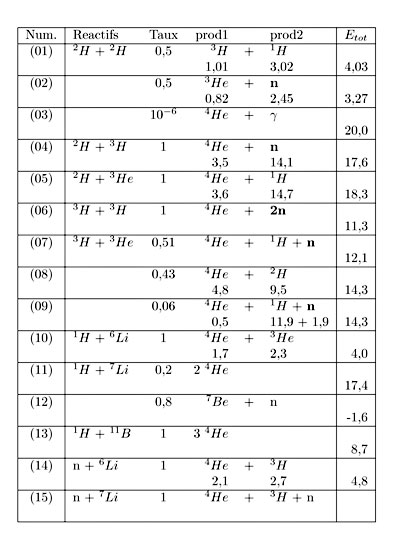
We may distinguish two kinds of reactions:
- those producing neutrons and gamma radiation: (02), (04), (06), (07), (09). The reaction (12) produces a neutron but should be put aside because it is endothermic. However coupling the two ways of Li-7 (11) + (12) is exothermic (balance: +2,2 MeV) and this reactional way could be interesting.
- those which produce only charged nuclei: protons, deutons, alpha particles (4He) : (01), (03), (05), (08), (09), (10) (11), (13), (14), (15).
The reactions of the first kind may seem at first unfavorable, as neutrons and gamma photons are not sensitive to electromagnetic fields, and so cannot be ejected by a conduit: their contribution to propulsion is zero whereas they carry the majority of the impulsion. Moreover they are very aggressive and “activate” the metal structures. On the other hand, the reactive nuclei are relatively abundant: these reactions imply deuterium in (3). The reactions of the second kind are ideal for propulsion but tritium is not naturally available and helium-3, lithium-6-7 and boron-11 are much more rare than deuterium in the small bodies of the solar system. However the required fuel mass is considerable, about 21 Gt (gigaton, 1 Gt = 1 billion tons) on the hypothesis adopted hereafter.
One possibility is to use the neutron produced to breed deuterium in a fertile layer of hydrogen 1H.
The D-D reaction has two equiprobable ways, (2) and (3). In the first, pn+pn produces pnn+p (a tritium nucleus and a proton), in the second ppn + n (a helium-3 nucleus and a neutron). The produced tritium is then likely to react in (5) pnn+pnn -> ppnn + 2n (a helium-4 nucleus and 2 neutrons). The two neutrons produced in this second stage of reaction may in their turn breed deuterium by reacting with the fertile layer of light hydrogen.
The great technical difficulty consists in -amongst other- not “wasting” impulse when passing from the first reactional stage (D-D) to the second (T-T, or He3-He3). The ejection velocity is the key parameter in determining the engine efficiency, and it is primarily allowed by the high temperatures of the reactions products. A proton at 20,000 km/s has a kinetic energy of about 4 MeV, which well represents the magnitude of the reactions described above. The second fusion reaction must thus occur within the jet of plasma. Whatever is the difficulty, a complete breeding (at 1:1 rate), even with a very slight surplus, represents an absolutely crucial factor to judge feasibility. The fusible isotopes are only present at the state of traces in the small bodies. A complete breeding only requires to take on board small initial quantities, since each gram undergoing fusion breeds one gram in the fertile layer. If breeding is only partial, it is needed before departure to distil enormous quantities of hydrogen so as to take on board a fuel already strongly enriched in deuterium or other fusible nuclei. The mass needed to provide fuel vary between 1 to 5000 between the two.
Another concept which may be interesting to consider, given the vast surface of the engine to be manufactured, is that of the ice rocket:2 frozen hydrogen and deuterium are used at the same time as reactor, conduit of fuel and screen against the products of the reaction.
Choice of the target: small bodies first
Paradoxically, the fact of travelling in a vessel-world makes it possible to be much less selective on the choice of the stellar target, and to get more chance to find one at short distance (on an astronomical scale). It is not indeed necessary to find a livable planet but simply a system including a star of a spectral type not very far away from the solar type (K, G or F) and abundance of small bodies. Of course, the presence of a planet offering a “practicable” surface, of Martian type for example would be very appreciable.
Among close systems, Epsilon Eridani (the system gravitating around the star designated epsilon in the constellation of Eridan) can be most interesting. It has been, by the way, the subject of research with the Green Bank radiotelescope in 1960, to seek signs of intelligent life, with negative results of course.
The system is a close neighbor of the Sun, which is its first criteria of choice. It is located at only 10.5 light-years (3.2 parsec). Ironically, Eridan is the name of the river where fell Phaeton after its disastrous race too close to the Sun. Let us wish to fall there while moving away from the Sun! The orange color star is rather close to the solar type (0.82 solar mass, spectral type K2 V).
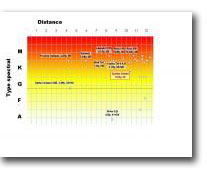 |
|||
| Click the image to zoom | |||
The infrared observation satellite IRAS detected much dust around the star, a possible indication of a planetary system in formation. It is thus very probable that the system abounds in small bodies. In august 2000, a planet of the size of Jupiter was detected at a distance of 3.2 UA (480 million km) from the star, in a strongly eccentric orbit (e=0.702) which makes it inside the ecosphere on a little more than 10% of its short orbital period (2502 days).
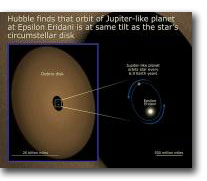 |
||||
| Click the image to zoom | ||||
If this planet has giant satellites, like Jupiter or Saturn, they could represent a semi-habitable rest place for the arkonauts.3
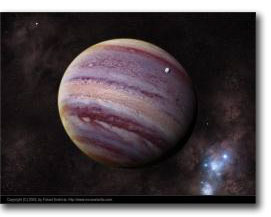 |
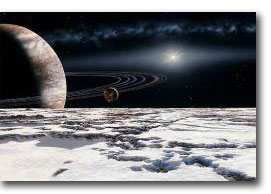 |
||
| Click the image to zoom | |||
Energy and travel time: the Tsiolkovski equation
The way to Epsilon Eridani will serve as a textbook case to evaluate SII strategy. We will consider a mean ejection velocity of 15,000 km/s. The fundamental Tsiolkovski equation, in its non-relativistic version (v/c<<1) gives the ratio of the departure mass to the structural mass needed to reach a velocity of v with an ejection velocity of ve :

with:
M0 : total departure mass.
M : mass of the structure without fuel
M0 = M + Mc, with Mc the fuel mass
ve : fuel ejection velocity
v : final velocity at the end of the acceleration period
After the acceleration phase, there is a period of coasting flight at constant velocity, then deceleration to arrive at destination at zero velocity. This implies more fuel since we need to accelerate in the first phase a mass of fuel which will only be consumed during braking, which translates into the squaring of the exponential:

The quantity of fuel determines final velocity and so, travel duration.
We note:
Da : acceleration and braking distances (cumulated)
Dl : coasting flight distance
We define k, the ratio fuel mass/total mass:

We set:

We have Ta, the acceleration and braking durations (cumulated):

Tl, the coasting flight duration:

One wishes the acceleration and braking duration the shortest possible, so as that most of the travel is at the maximum speed. But on the other side an intense acceleration implies a strong thrust and so more massive engines and reinforced structure, to resist the thrust without deformation.
A technology being given, defining the fuel ejection velocity (ve = 15,000 km/s) it remains two free parameters to calculate the travel duration (t), the average acceleration (a) and the thrust (f) : the fuel mass Mc and the acceleration distance Da (it is supposed that acceleration and braking are totally symmetric). In the graph below, we represent the variation of the three output variables (t, a, f ) as a function of the two input (Mc and Da).
We cannot yet carry out a reasoned choice of the input values. We know simply that we should if possible maximize Mc and minimize Da. Mc consists of fusible substance, a rare material (undoubtely deuterium for the most part). Of all the parameters which condition the feasibility of a gigaton-mass Ark, the mass of the fuel to be extracted from small bodies is undoubtedly the one which poses the most acute problems. The illustration below represents an alternative solution, a photonic sail, making it possible to reduce the structure.4 Propelled by fixed laser of very great power, for example installed on the Moon, the Ark would only take on board the braking fuel. Even with its immense surface, the sail insolation reaches more than 1000 times the solar constant in terrestrial orbit (1400 W/m²) : surface must be perfectly reflective in order not to be evaporated by the receiving power. Also, the Ark would depend on an external source which it does not control.
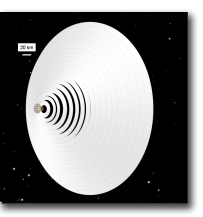
Click the image to zoom
For the following, we will adopt the solution of a completely autonomous acceleration with the illustrative ratio M0/M necessary to reach 1.5% of c, that is 4500 km/s. This requires a total departure mass of 46 Gt (25 for structure and 21 for fuel). For a cumulated acceleration and braking distance of 0.5 ly, one obtains an accelerated flight duration of 67 years (34 years for the acceleration and as much for braking), and a coasting flight duration of 667 years, that is a total travel duration of 734 years, to traverse 10.5 ly separating us from Epsilon Eridani.
The Ark structure, its philosophy in brief
The long strategy is based on the construction of a structure, the Ark, within which a small population, the Space Nation, could live an independent existence. This structure must allow a life at the same time completely free from Earth, organized as a whole nation and with enough diversity on all plans of interaction under which we consider the individual life.
When one wants to represent oneself physically what the Ark would look like, three preliminary constraints prove strong enough to define its general architecture.
a) Artificial gravity
The Ark must allow a normal life, according to terrestrial standards, and the first requirement relates to gravity. The acceleration of gravity results from the enormous mass of the Earth (5.97E24 kg) and it is obviously impossible to recreate it in this manner. The only alternative solution is to circularly accelerate a cylindrical surface inside which the habitants take place. The acceleration g is then:

with:
g the acceleration in m.s-2
 the angular velocity in rad.-1
the angular velocity in rad.-1
R the cylinder radius in m
The acceleration g is set equal to Earth’s, that is 9.81 m/s². Ark radius, discussed below, is 5 km. So:

 = 0.044 rad.-1, that is a revolution period of 2 min 22 s.
= 0.044 rad.-1, that is a revolution period of 2 min 22 s.
The structure being of kilometric dimensions, the concerned mass, both for structure and fuel, will be important. Subjecting a mass to an acceleration produces a force, so as the structure needs to be reinforced so that it resists its own weight. Concerning the habitable structure, there is no choice, but concerning the fuel and the engine, one may find it very beneficial not to make them turn with the structure, so as they remain in weightlessness. The cylinder axis offers naturally a space of weightlessness: acceleration depends linearly on distance from center. For R=0, g=0. So, all the engine part should take seat in the center, or Hub of the Ark cylinder.
b) Thrust surface
However, doing a preliminary calculation of the necessary surface of the engines (as each engine is only able to provide a finite and small thrust) we find that is must be far higher than the section of a 5 km cylinder. It is thus necessary to couple to the Ark cylinder a vast thrust surface which should not rotate in order to avoid a structure overweight, while transmitting its thrust to the whole structure.
A first solution would be to place this corolla in the form of a vast ring and to connect it with cables to the cylinder hub. In this approximate version, the Ark would be drawn like princess Elisa by her eleven brothers transformed into swans in the Andersen’s tale of the “Wild Swans”.
Click the image to zoom
But if the eleven brothers had all softness for their young sister, it would emanate from the corolla a plasma blowing to ten thousands km/s as well as a flood of gamma photons, all very aggressive and extremely detrimental to any structure located under the flow.
The corolla will thus be placed behind. One should imagine the Ark as a motionless disk, the corolla, connected to a turning cylinder, the livable structure, located in front.
The architectural challenge is to transmit to the cylinder the thrust of the disk, without this coupling implying the rotation of the disk. Without also making the cylinder ‘dance’, which would occuper by gyroscopic effect if the thrust axis does not strictly merge with the revolution axis. The coupling of the two elements can only be done in one point, and this point must be located at the exact geometrical center of the Ark. Application of thrust in a single point of small surface, the central stage (diameter ~ 25 m), makes it possible to limit friction which would insidiously transmit the rotational movement of the cylinder to the corolla.
It should be added to that that the disk is not made of very rigid elements. It is essentially made of not very cohesive hydrogen ice. Such a surface cannot work in shearing. It would be the case if the corolla were to directly push on the cylinder by its center. A structure doubling the corolla, rigid enough to collect the thrust on all surface and to work directly in shearing should be extremely massive. The general rule for structures of very long range it is that a load-carrying element working in compression (as the walls of a house) is much more massive than a load-carrying element in traction (such as a cable), for an equal stress. And this more especially as the range increases. This is why it is difficult to build very high towers on Earth. Here, there are no other choices that to make the corolla work in traction, according to fasteners regularly laid out along its perimeter and its rays, by staying it to a beam which will transmit the thrust to the center of the Ark, via a bearing. This beam becomes the only element to work in compression.
At midway, we remember to reverse the thrust, so as to arrive at destination at null velocity. To turn around a structure of this size is as much less easy if its moment of inertia perpendicular to the axis of rotation is large, which is the case. It is simpler to have a second corolla, symmetrical with the first, on the front side, so as the braking jet may be correctly directed to the target when needed. The tick cushion of hydrogen ice which would form on the behind would secure the Ark from collisions with small interstellar bodies, which is very rare but devastating at a velocity of 4,500 km/s.
Click the image to zoom
c) The mass of the structure
The dry mass of the Ark as discussed here represents some 25 Gt (gigatons) or 2.5E13 kg. It would be necessary, of course, to discuss the basis of this estimation and the parameters which can intervene to reconsider it. But in any case, one has a presentiment that for a kilometric structure under tension it must be question of “gigatonnic” mass. A take-off of such structure from the Earth would be whimsical. The gravitational well is too deep and the body should be unreasonably reinforced to resist to the departure thrust. Construction will have thus to be done entirely in space. But even then, the contribution of materials neessary for its construction could not realistically come from Earth, because of energy requirements. The extraction would be done preferentially from small bodies of the solar system (asteroids and comets), whose gravity well is tiny, then conveyed in terrestrial orbit. The structure of the Ark is much larger and massive than any human artifact ever considered, and it is also that which should remain intact over the longest duration, with absolute requirements of resistance and sealing. To satisfy only one of these two requirements would require a new reflection. It is a fortiori the case when both are joined. With some exceptions, of which the structure of the first aircrafts in wood and textiles, all aereonautical structures are metalilc. There exist in the solar sytem a rather large abundance of small metallic bodies, the asteroids of type S which account for 17% of all known asteroids : even concentrating on the only light metal elements (Al, Mg, Ti…) abundance is not a problem. But to conceive a structure entirely made of metal by conventional means is hardly possible, for several reasons. Metals at native state are in the form of oxides (combined with oxygen: XnOm) and their reduction (to make them pure metals) requires high temperatures or intense amperages, which implies mass production of electrical energy. Their shaping and assembly are also energy-expensive and claim much care. They are dense bodies with a rather modest ratio of resistance in tension over specific mass. They are subjected to a phenomenon of tiredness (dislocations in the crystal lattice) which rigidify them and lead to the formation of cracks. They are oxydable in various ways, while at the same time the Ark’s interior is erosive (seasonal atmospheric cycle, humid air, oceanic layer..).
Considering by contrast that the chemical elements which mainly make the small bodies of the solar systems are lighter than metals, and that one seeks a light structure, and considering in addition that even if we are not the authors, thanks to Evolution we have in Plants an immense natural know-how in the construction of fibrous structures both resistant and self-sustained on the basis of light atoms tied to solar energy available in abundance, we come to imagine that the structure of the Ark could be built by natural growth, rather than by construction, with vegetable fiber walls. The components are as said, lighter and more abundant (CHON), they offer an excellent ratio resistance/weight and are of very safe design (they “prevent” before yielding). Especially: they are regenerated, that of which no traditional structure is able. It may seem iconoclast enough to put a ‘vegetable’ in the spatial vacuum. However, the only thing to ensure is to isolate the living cells from this vacuum, and here too biological operation can take care of it by production of a cohesive skin of dead cells in a rubber-like matrix, over some decimeters. The other advantage relates to the construction: engineering simply resumes to nourish an alive structure with simple elements taken from small bodies: H2O, CO2, nitrogen, phosphorus… The structure grows on interior orbit, by using solar energy, from an embryonic stage to kilometric adult dimensions in two or three centuries. During this lapse of time, it is habitable by its host builders. On the interstellar way, it is then necessary to provide the energy of maintenance in luminous form.
The Ark’s biosphere is made of an oceanic film, of a depth of approximately 25m, on which float ballast supporting a thin soil.
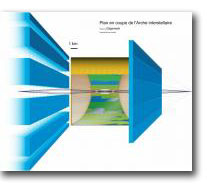 |
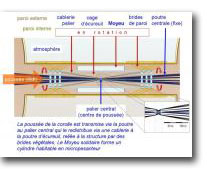 |
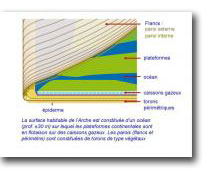 |
|
| Click the image to zoom | |||
An entire life in the Ark ?
Can one seriously consider a normal life, accomplished on all the plans, within an artificial structure far away from the Earth? Could we do it by ourselves and could we imagine without quivering a line of generations living there, which we would be the ancestor? This prospect undoubtedly constitutes the most immediate psychological brake, but not inevitably the deepest, that every normally made human being will oppose first of all to the idea of a life in the Ark.
To approach this central point, we will use of a concept that one could call the individual horizon, which parameter is a radius defined as the depth of action of the individual, on the level considered essential to an existence deserving to be lived. On all these plans, one seeks the minimum radius for which these requirements are satisfied, if it is not fully at least by combining them when it is possible.
Horizon of visual space: Dimension in which the radius is expressed: extent of the land which can be seen at a glance. It is the first signification apperception of the space, and it dimensions the whole project. On Earth, which is the radius of our visual horizon? From 1 to approximately 10 km depending on landscape. This defines the typical dimensions of the Ark. Concretely, the glance goes sufficiently far without giving the impression to feel at narrow. On the ground, a thickness of 1 to 10m of topsoil and rocks is enough.
Physical horizon of circulation: Dimension of the radius: the surface or volume which can be explored by an individual. On Earth the glance goes from 1 to 10 km, but we can move within a far bigger space, like thousands or even millions of km². From this point of view, it appears frankly impossible to reproduce what potentially offers us the whole Earth. However few individuals on Earth realize such potential in their life. A majority of people, considered in the space-time of their existence, their whole horizon of circulation does not exceed a few hundred km².
One can add to this that the radius of this horizon may be appreciably increased if there is great diversity. A thousand km² of desert do not offer the same radius of action, on that level, than a hundred km² in which one would find a city, a forest, fields, a river and any other elements of landscape diversity. One would want to maximize from this point of view the diversity offered by the natural environments of the Ark by reproducing the main part of the great terrestrial ecosystems.
Moreover, an artificial structure as the Ark offers by its design several levels, going from the center towards the periphery, while terrestrial surface is presented as purement bi-dimensional, without thickness to be explored with the exception of sea-beds or cavities. These various levels offer a completely new diversity unknown on Earth: micro-gravity spaces, spacewalk on the central beam or in galleries within the fuel hydrogen ice, oceanic background and other surfaces and volumes which will be detailed when discussing the structure. All places in the Ark, in surface as in volume, can be designed to be accessible at walk. Some will be very diversified, others rather monotonous. Together, they offer a very large radius of circulation. The maximum visual horizon being about 10 Km, one can start to consider on the same basis the habitation area. It would be a cylindric surface of length L=10 Km on a diameter of 10 Km (or a radius of 5 Km). The habitable surface A0 is:
A0 = 2πRL
That is A0 = 314 km², representing the primary radius of the circulation horizon, something like ‘dry land’, offering conditions of existence in all points comparable to terrestrial standards. It is difficult to rigorously quantify what the spaces developed on the basis of this primary radius represent, since surfaces and volumes are concerned at the same time. Without claiming to give anything other than an estimation, one can however ensure that this radius will be multiplied by ten. In magnitude, an Ark whose visual space horizon is set to 10 km should offer a space of circulation comparable to a space on Earth that a horse can traverse during one day.
Of course, even if one does not feel at narrow in such radius of circulation, it could look very thin when one imagines – and how not to do it - about the terrestrial immensities. But two plans are then confused. Terrestrial space, let us repeat it, is only potentially available to us. Only a negligible minority of people happen to travel from one pole to another or through all timezones. And even the great travelers never explore more than what is within reach of their steps. When we go to China, which we explore best is the seat of the airplane taking us there. And it would be specious to affirm to have been “crossing Japan” because one flew over it at 10,000 meters of altitude. And when one visited China, the actual radius of circulation was by no means comparable to the size of this nation. It was summarized to some visited places, some natural curiosities, a city or two, and within these cities a few remarkable places, with our hotel room probably the best explored place of all the tour, said without any irony. The real circulation space is not indexed to terrestrial vastness but to time. That is the actual criterion. The fact of potentially having an immense world is not at all negligible. But that is a moral aspect which should be considered separately. It may seem important that a vast world is available where to carry our steps, but if one adds up over our whole lifetime the spaces where one will have been able indeed to note our presence, it is probable that they will not exceed the radius of circulation under consideration for the Ark.
Horizon of social interaction: Radius dimension: number and diversity of the arkonauts population. The term arkonaut designates the inhabitants of the Ark. To reach the minimal threshold of diversity, it is needed in other words that one can during his whole life meet people who he never met before. It is also what one could call the threshold of anonymity: while walking in the crowd, one meet unknown people in proportion as large as known people. That corresponds to what happens in a small city, that is a population ranging between 10,000 and 100,000 inhabitants, with an average set for the convenience of this article to 50,000 inhabitants.
Comparing to Earth, Ark should carry a maximized human diversity. However, it is undoubtedly necessary to imagine that the settlement is done primarily by natural growth. The initial settlement, carrying out the way Ground-Ark could include as few as 2,000 families or 5,000 people, adults and their offsprings, knowledgeable in fields useful to construction and maintenance of the structure and the engines. And for the successor, a “meritocratic” ascent formed of volunteers selected for their social utility within the framework of the project. The time of acclimatization and demographic balancing, including the possibility of a return to Earth, will undoubtedly be higher than a century.
Horizon of social activities: Radius dimension: diversity and intensity of the activities constituting the reason to act at the collective level of individuals. An Ark carrying a branch of humanity towards a nearby stellar system, on secular durations, would structure around two primary functions: ensure propulsion of the engine, and maintain the life.
Propulsion: it consists of two symmetrical phases, acceleration and braking. Between the two, the Ark is in coasting flight at maximum speed. As one wishes to carry out the maximum of the way at this maximum speed, in ordern to shorten it, one will seek to reduce as much as possible the duration of the phases of acceleration and braking, and the coasting flight will have to represent the major part of it. Also the strictly propelling function should only concern a short segment of a few decades before departure and preceding arrival. However, the competences concerned with the propelling function preserve an essential preroagative during coasting flight: provide the energy needed to maintain the life in the Ark, that is for the main part the solar energy (when the term does not carry confusion, we will use it to indicate luminous energy) diffused within the structure and allowing life of the ecosystems, as well as the maintenance of the “thermodynamic machine” regulating Ark climate. The energy used by the anthropic activities (industry, transportation, domestic activity) is included, representing a negligible sub-total. Physically, this function is achieved in the center of the Ark, in what one will indicate as the Hub, in a microgravity area, as well as in the Beam and within the corolla, in weightlessness (or almost, since the mass of the structure will create a natural gravity of a millionth gram). One will include in the activity of the Hub all the industrial activities which it may be interesting to perform in low weight.
Life: it is at the same time about the interior ecosystem of the Ark (content) and its walls (container). The Ark is a closed system with a short cycle if compared to those known on Earth. Given the immediate cause/effect relationship between the global functioning of the Ark and the existence of its inhabitants, one can predict that those will develop particularly sharpened skills. The Ark being globally, and totally, an alive being, it represents a source of constant interactions for its inhabitants, either if it question of taking care of it or to be looked after from it. The nature of the “propulsion-life” bond represents something philosophically stimulating, because of the “mise en abyme” of the action which it founds. The Ark shelters man, and man injects energy making it possible to the Ark to live. That resembles the endosymbiose joining together the eucaryotes cells and the mitochondries. It is about a relationship of total mutual dependance, in a conscient form at one part (asymmetry founding a total responsibility) and which seals a unity of destiny all the more intensely felt than an alive being is totally master and totally slave of an another. Interesting dialectical. On the level of individual moral construction founding political systems, the small number of the population is an asset to develop an “Athenian” democracy without political representative body, which increases the richness of social interaction of individuals, insofar as a direct and not mediated power is exerted.
Genesic horizon: Radius dimension: capacity to generate. A very delicate question would be that of demographical control. The Ark being a closed world largely optimized, there is no question of leaving the simple natural growth to control demography. One does not need either to set excessive constraints, population being able without any doubt to grow of up to a factor of 3 without consequent damage. However, the question would be obligatorily set for a so long duration that the balance between personal freedom and collective interest should be solved theoretically. Within a democratic framework one can imagine the following social pact. The first child would constitute an indisputable right, that each woman would concretize when she would like it, with the simple duty of declaring it to allow for demographical planning. The extension of the family to two children would then be decided at random depending on the balance requirements formulated by demographic projections. Concretely, each woman would declare each year their “child project” for that year, in yes/no form, and for the whole of their fertile period (I would desire N children in all). That would be a simple declaration, revisable without notice and nonconstraining. One would draw a demographic projection from it, from which an opinion would result, in the form of a random choice. Each troop of women (a troop is defined by individuals of the same age) would be entitled to the random choice. The randomized names would depend on the wish expressed for the year (if a woman desires a child on that year, his name would be in the list to be randomized) and each name would be weighted in proportion of their parental project already carried out (a woman wishing 3 childrens and not having any would have more rights than a woman wishing 4 childrens and already having 3). The remaining question, subjected to the political appreciation of the arkonauts, would be to determine the applicable constraint (if any) when a woman falls pregnant when the random choice had not granted child to her. If the wishes not carried out by other woman in the troop balances it then all is well. The question takes a more delicate turn if the total indiscipline of a troop would burden the procreative right of the youngers. At worst one can imagine a penal sanction, but it is foreseeable that, like all social constraints originating with a very comprehensibile need, education would suffice so that things occur orderly or almost.
Spiritual horizon: Radius dimension: intensity and diversity of spiritual life, intended as the whole of the activities mobilizing cognition. A way of measuring the radius of this horizon could be to evaluate the depth and the richness of the materials available to mind to think about reality and itself.
Compared to what the Past can deliver, the Ark would embark the whole of terrestrial memories which should represent some 1E20 bytes in magnitude, that is the whole of what is currently registered on paper, magnetic or optical media, with or without repetition, everywhere and in all languages. The Ark will also have access to a “differed present” thanks to the radioelectric link with the Earth, all the more differed since the Ark is moving away. A laser link could be imagined, so as to minimize dispersion, in the infrared band which would get less noise from the plasma emissions. For a laser power of 1 MW at lambda = 1 micron, the bandwidth would be of magnitude of 10 MB/s at 1 ly and 100 KB/s at 10 ly, similar to an average internet link.
Compared to the Present, the spiritual horizon is identified to the horizon of social activity previously discussed. Arkonauts live a morally new situation, in lived and in long-term aims. They should develop an original mentality. The need of getting along would come first. The word trajectory reminds of “transient”. But such transient is a whole life and a whole civilization, with the result that the stellar goal will become almost secondary. The majority of individuals populating this travel will belong to a generation “not leaving, not arriving”. For this majority, the end of the way would just appear like a distant future. Certainly, in background the reach of targets will structure the community, but the stake making the happiness of the travellers will remain for the humankind its present.
Compared to the Future, the colonial objective will require a thorough reflection of what will have to be done once arrived at destination.
Either the target planets present conditions of existence allowing a settlement “naked head”, either they require terraformation. With the first case is associated a weak probability, as previously said. It is thus rather necessary to imagine a life of orbital two-ways travels between an Ark forming a comfortable base camp and life on surface in protected conditions. A terraformation represents a long-term task, exceeding individual lifespan, and arkonauts would live again what lived their ancestors who built the Ark, with this only difference that for the ancestors the base was a planet and their future horizon the Ark, while for the newcomers the base will be the Ark and their future horizon, the planet which becomes gradually livable.
To the multi-century duration of the task, there is a real ethical problem, which arises in all cases where the target planet is not deprived of life: what to do with indigenous life ?Of course, one does not imagine to colonize a planet populated by beings morally equivalent to the human being. But if the planet is ready to receive a form of life based on the chemistry of carbon, then it is possible, to differing degrees, that this one already developed at its surface or in sub-surface an original form of life without continuity with the forms of terrestrial lives which contain the Ark. The idea to sterilize a biosphere appears at the very least monstrous. On this assumption, it is necessary to imagine the existence within a mixed ecosystem.
As a conclusion
The travel duration, more than seven centuries on the adopted hypothesis, constitutes the most striking characteristic of an interstellar travel led by classical means. The most immediate objection which comes to the mind is that it would be perhaps wiser to wait that Physics makes sufficient progress to authorize interstellar travel in “decent” durations. And partly, history of physics seems to encourage us there. Few fields of knowledge indeed progressed at a faster rate than physics over the last four centuries. But on another side, in fact precisely the already achieved progress, crystallized in a solid building, shows well and to the point that crossing of immense spaces is expensive, either in time or energy. Perhaps is physics mature enough so that we should take it seriously as of today? To abolish time while spending immense quantities of energy does not cost anything to imagination, but nevertheless, energy keeps a rare good. Would not be time to drop sterile dreams to embrace fertile dreams? It is on this bet that this reflection was carried out. Energy is for humanity an exogenic good which must be extracted to the Universe, it is a conquest. As the fable says, “One fights for everything he swallows”. Humanity however has its time. It renews itself with its generations. It does not require, to last without effort, of nothing else than a reconstituted environment and a modest amount of energy to maintain it. And yet, even in the long strategy, one need an insane amount of energy. 99% of fuel disperse in the Great Outside and propels the Ark, 1% only feeds the sun shining on such a world.
At the scale of the beginning of XXI century, the Ark is a project at the border of fantasy. Everything appears disproportionate, whether it is the amount of fuel or the dimensions of the structure. But to set the real height which is necessary to cross, to set masses, lengths and energies, to determine the level of technological advance of the travellers, draw the broad outline of a society to come, all of this, even if future would not retain nothing of it, may help the birth of a future.
- For more details check https://math.ucr.edu/home/baez/physics/Relativity/SR/rocket.html [↩]
- J. Post, “Hydrogen ice spacecraft“, AIAA, Space Programs and Technologies Conference, Huntsville, AL; (1990) [↩]
- A simulation of the system can be seen here: https://media4.obspm.fr/exoplanetes/base/systeme.php?etoile=Epsilon+Eridani [↩]
- G. A. Landis, “Small Laser-propelled Interstellar Probe“, Presented at the 46th International Astronautical Congress, Oslo, Norway (1995) [↩]
You can leave a reply, or trackback from your own site.
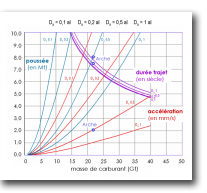

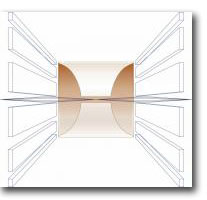

16 February 2007, 2:00 am
One approach to widen the horizon of circulation could be to rely on immersive virtual reality, which should be within the technological range of this project, so as to take aboard a detailed reproduction of Earth’s surface, including cities and landscapes, and to be used as well as a ground of exploration of toy worlds in order to prepare future colonization. That suggests that the computational power of arkonauts could be as important as their propulsion power, in such a travel toward new worlds.
18 February 2007, 4:20 pm
Option four: Genetically engineer a much longer human health span.
Once the human life-span is up to 70million years, spending a few thousand years to travel to a new planet will not seem like a large investment of time
18 February 2007, 5:26 pm
I’m on the side of various SciFi stories which show such an Ark’s population rapidly losing any memory or concept of Earth. The residents soon form their own religion(s), view the Ark as the one and only locale on which humans reside, and so on. In fact, after a few centuries, it’s more likely that, should a habitable planet be found, the religiious proscriptions against leaving the Ark would stop them from so much as attempting an exploratory landing on a orbit-bound environment (as opposed to the free-flying Ark).
18 February 2007, 5:32 pm
Wow! What a great article, really.
However, there is two points I would be very interested to get your opinion about :
1- Hibernation.
You mention possibility of a “hibernating crew” in SP1, but didn’t get too deep about it. Hibernation is often considered as the most “possible” way to make mankind to travel in outer space and seems pretty much in reach of our current technology, when compared to the ark. What do you think about it? I don’t know the scientific point of view on the subjet but I’m very curious about it, as it seems _almost_ realistic.
2- Collision.
What’s about collision with smaller object while travelling? Correct me if I am wrong, but colliding the ark with literrally _anything_ (big dust, rock) at this speed, would happen to be devastating. Even assuming the hull is not breached, dust collision would probably cause the ark to “erode” (some kind of). The hydrogen ice part does not seem very safe,as it does nothing but to reduce the probability of a dangerous collision on “a vital point”, since the ice “shield” most of it.
Is the probability of collision while travelling during century is that low or shouldn’t the ark be equiped with some kind of “deflector” (or any kind of “protective shield”)?
18 February 2007, 5:46 pm
Given the
1. technology of programed self-replicating machinery (down to nan-scale),
2. the ability for those machines to harvest raw materials from a target solar system,
3. a technology that will allow the machinery to use genetic information, human developmental information and artificial wombs to allow for the birth of a generation of humans de novo at the target system once preparations have been made,
Many of the constraints of the above disappear.
18 February 2007, 5:51 pm
We already have an “ark”. We just have to provide a sun-replacement in orbit, and take the entire system (planet, solar replacement) with us.
Great article.
18 February 2007, 6:10 pm
Humanity in 140 generations produced multiple “religions,” despots, plagues, and self-destructive tendancies, enough to frighten even the hoplessly optimistic, but evidently not all. The unravleing of the social fabric abord the ark is an intrigueing subject of speculation, say sometime during the 90th generation as all chaos reigns a smalll group discover early records from the departure at homeworld…
The spread of humanity an irrational infection, maddness.
I love the article.
18 February 2007, 6:11 pm
Can’t we just send all our Accountants, Middle Managers, Account Executives, and Telephone Sanitizers? We can call it the “B” Arc.
IMarv
18 February 2007, 6:13 pm
Alan, the problem is exactly the same if one takes as a basis a lifespan of 70 M years (wow!). Arkonauts are human beings, they seek the same happiness, the same quality of life as those who live on Earth, I think it is realistic to say that. Nobody plans to live, generate and die in a jam jar. One thus needs a structure able to ensure such quality of life.
18 February 2007, 6:20 pm
The fuel/energy requirements for deceleration are not necessarily as high as you calculated - you should be able to use the gravity of the destination star system for a large part of that.
18 February 2007, 6:26 pm
This comment is up for debate, but I want to offer a different source of power.
Stellar, Interstellar, Galactic, and Intergalactic space is composed of plasma. Generally referred by astronomers as super-heated gas or ionized gas. All three of these are the same thing and are very electrically excited.
There are currents of electricity connecting stars together called Birkland Currents. The target star should be one that is electrically connected to our Sun and the ark could tap into it to provide power. Life on Earth would also do well if we could tap into the interstellar power grid.
IMarv
18 February 2007, 6:38 pm
It seems to me that an interstellar ark would work well if one of its major agricultural products is cannabis magnifica. The time would seem to flow so much faster for everyone if a fine mist of the stuff were flowing everywhere.
18 February 2007, 6:56 pm
[…] How do you get from one star system to another? Build an ark complete with mountains, oceans, and cities. An article entitled Interstellar Ark provides the details on how we can achieve this feat. This is a far out idea. I like it. My only criticism is the underlying notion that we need to find other habitable planets to colonize. What are we, barnacles? Do we have to keep on jumping from one rock to another? Let’s just build the ark and go for a joy ride around the universe. There’s no need to stop and get stuck on another planet. Still, the article is a fascinating read, even with all the math thrown in. Trackback · […]
18 February 2007, 7:01 pm
Carl, the travel is “just” seven centuries. Yes, that is a long time. But that remains largely in the magnitude of historical durations for which we keep a very sharp memory of civilization, great men or events. We are able to reconstitute the daily activities of people in the Rome of 1st century BC, 2100 years before present, and we know what we owe to this civilization. We remember well Alexander the Great, who lived 2300 years ago.
Moreover, the “radio” link with Earth is preserved. Calculation is mentioned in the article. Using an IR laser link, with an emission power of 1 MW, one gets a bandwidth to Earth of 10 MB/s within 1 light-year and 100 KB/s within 10 light-years, similar to a normal internet connection.
On the other hand, I agree with you that the moral and spiritual trajectory of these people could be new. One may consider that a kind of civic worship of the Arch would develop, Arch considered as a living being depending on travellers as travellers are depending on the Arch.
The linguistic problem is also interesting to consider. I imagine a bilinguism with an “arkean” language, for public expression, undoubtedly an anglophone Creole, and “archaic” terrestrial languages which would keep a right.
For settlement of the distant world, I consider difficult that at 10 ly from the Earth (it is really the outskirts of the solar system) one can find a livable planet just like the Earth. It would be an incredible stroke of luck. The Arch would thus remain “the” place of reference, no matter the religious interdict. The host planet would become populated only very gradually, without urge. In fact, finding a distant planet is not really the first goal, what is essential is to find energy near another star.
18 February 2007, 8:01 pm
Thank you HE
Hibernation is indeed often mentioned as a possible solution, but I think that it is a mistake. True, the vessel being less massive one could go quicker, say to c/10 with a small vessel. But even at this speed, the travel would still take one century. The calculation mentioned at the beginning of the article gives what would be possible by taking full advantage of relativistic proper time slowdown. But that means that one must master massive fuel ejection at speeds much higher than c/10 (which would be the coasting flight speed). One can accelerate particles at ultra-relativistic speed in large accelerators, but at the price of enormous amounts of electric power. Here, it is the fuel itself which should provide the energy for its own ejection, or it will not work. And it is not possible with thermonuclear fusion to exceed temperatures of 10 MeV, so one is still far from relativistic speeds.
Thus we have a travel which remains of about one century, for the nearest target. The crucial question which arises then is: does hibernation makes it possible to lengthen human life at the point of largely exceeding one century?
Because obviously, it would be useless to make asleep thousands of people if they would awake as old men on arrival! It is necessary to awake people in full possession of their faculties, say less than 60 years on average. The phenomenon of hibernation such as we know it, does not make it possible to lengthen the life of the mammals practicing it, it is just to spend winter and avoid food shortage.
Hibernation would just avoid finding the wait too long and suffering from the exiguity of a small vessel. But, if there are “sleepers”, inevitably there would be also “watchers”. I do not imagine for a second a vessel of “Sleeping Beauties” where only computers take care of everything. I think that whoever knows computers a little knows why this is not realistic
It is thus necessary to imagine that groups of people would in turn awake, make decisions and bring up children. For that one needs a minimum of comfort, therefore of space and natural environment.
Finally there is the arrival. The planet most probably does not present all terrestrial standards. Perhaps with some luck one will find something like Mars : it would be already fantastic. Thus one would need at first to make closed buildings as comfortable as on Earth. To build them, one need many people, and lot of time, surely more than one generation. And a comfortable environment is still needed in the wait, which by hypothesis cannot be the vessel himself.
By any viewpoint one considers the problem, a “quick” travel duration implies some kind of bottleneck.
Now about the risk of collision. Interstellar space is empty, but really empty, at a point which one can difficult imagine. And that is already the case for the interplanetary space. On the other hand it is true that consequences of a collision with meter-sized bodies are indeed devastating at 4500 km/s. Calculation made, it appears that it is already problematic for centimeter-sized bodies. There are several lines of defense :
1. A radar on the front, and possibility of maneuvering the Arch. One needs approximately 1 hour to move the arch away from its trajectory of a distance equal to its diameter. The corolla is indeed directional within ±10°. One can imagine that the maneuvering would be precisely defined, in order to be able to go “full power” in very little time.
2. Mirrors with temporal reversal. By amplifying the received echo towards the target, one could concentrate a great amount of energy so as to vaporize it.
3. Electromagnetic shoot. The central beam on the front (> 10 km) can shelter an electromagnetic accelerator making it possible to send projectiles on the target
4. Alarm probes. On the front of the Arch, several probes could fly with an advance of several months to check for bodies.
5. The fuel shield would secure the Arch against any impacts of bodies smaller than a centimeter.
6. In the worst case, a collision would make a hole in the Arch, from side to side. If this happens, it would be possible to empty the ballast of perpendicular continents so that they fall in the hole, stopping it while waiting to repair it.
18 February 2007, 8:02 pm
I like the article, it’s very futurist and represents the kind of endeavor that leaves a positive mark on history, however I am constantly abhored by negative statements about what can or cannot be accomplished.
Specifically, the comment “the famous constant of Einstein c, the speed of light (3E8 m/s), represents an horizon speed which is impossible to exceed and which is even extraordinarily difficult to approach,” which strikes me as shortsighted and similar to the things people used to say about flight, or going to the moon, or the sound barrier, or for that matter, hundreds if not thousands of scientific and technical achievements.
I prefer to maintain an open mind, something I think scientists should always do.
18 February 2007, 8:46 pm
Hmm, no, I do not see how the gravity of the distant system could be made profitable. The target star would accelerate the Ark towards it, not slow it down. For Epsilon Eridani, the escape velocity at 1 astronomical unit from the star is approximately 38 km/s. It is then needed to add this velocity to the 4500 km/s coasting flight velocity, that is a supplement of 0.9% (in fact less, because approximately 30 km/s out of the 38 will be used to put the Arch into orbit around the target star).
18 February 2007, 8:51 pm
Thank you Ben.
Yes, we have a natural ark, and the interstellar ark is not there to replace it. In all, just 5 000 or 10 000 people would leave the Earth to live in the Ark (and then would grow naturally). That is completely negligible compared to the 6 billion people that we are on Earth.
18 February 2007, 9:06 pm
Todd, I ensure you that I am one of those who are deeply troubled by pessimistic considerations about man’s nature (like, we are too stupid, too evil, etc). I am deeply optimistic. But one thing is sure : we do not decide how Nature is. If c is a limiting velocity, it could be that it is like that, and that’s all. This has nothing to do with our moral or intellectural nature. It is not a punishment. Nobody wants to harm us with that. But the deepest physical theories shows that it is a limiting velocity. It is not at all like the sound barrier for example, it is much more fundamental. The question is: what do we do then? The refuse to recognize it? We acccept it and we resign to do nothing? Or we accept it and we put ourselves in the position to go nevertheless?
18 February 2007, 9:12 pm
In 700 years it is not unlikely that the human species will have either transcended itself into machines or wiped itself out.
We are probably unable to build anything complicated (outside of a few large stone buildings) that can last a few centuries.
This ark is a nice fantasy. We are stuck on this planetary system for a long while, unless some spectacular new physics comes along.